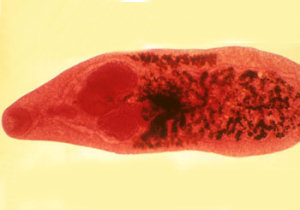© 2007 All Rights Reserved. Do not distribute or repurpose this work without written permission from the copyright holder(s).
Printed from https://danginteresting.com/a-fluke-of-nature/

As the sun rises over a grassy pasture, and the morning light glints from the countless clinging drops of dew, a single snail resolutely inches toward a mound of steaming nourishment. But unbeknownst to the armored gastropod, this seemingly ordinary heap of cow dung conceals a legion of tiny Dicrocoelium dendriticum eggs, each of which contains the embryo of a sinister mind-controlling parasite. As the snail gorges itself on the fibrous feast, it unwittingly sets the collection of unborn lancet flukes on a miniature adventure which will lead them through slime, zombies, and bile to ultimately find their own unique kind of utopia.
As the ingested eggs slide into the snail’s belly, the moisture and digestive juices coax the occupants from their shells. Propelled by the minuscule hairs that line the flukes’ bodies, the infant parasites grope their way through the darkness to the hapless host’s digestive gland. There they establish a makeshift home as they mature into tadpole-like adolescence.
Once they’re ready to venture out on their own, the young flukes leave the warm comfort of the snail-gut. They make their way to their host’s respiratory chamber, where they gather in groups along the inner wall and wait. Their presence irritates the inner lining of the breathing cavity, which tries to rid itself of the foreign invaders by coating them with a thick mucus. When these slime-pearls reach a sufficient size, the snail coughs them out, ejecting the sticky groups of flukes out into the world. Lying there, sealed in their moist protective cocoon, the young parasites bide their time alongside hundreds of mucus-mates. The snail meanders off on its own, having suffered no harm aside from a particularly phlegmy cough.

A nearby ant which is foraging for food stumbles upon one such slime ball in a bed of vegetation. The sweet snail-mucus pheromones present an irresistible treat for the ant, and it totes the treasure back to the colony. As the slime is savored by the insects, the clandestine flukes infiltrate the ants’ anatomies. Most of the parasites make their way to the abdomen, but a few take a detour which leads them to the insect’s nerve center, where they use mysterious methods to establish overpowering influence.
The next evening, as the armies of ants file back to their colony after a long day’s work in the hot sun, those who partook of the sweet slime uncharacteristically break ranks to wander away in a daze. Acting out the demands of the unwelcome guests lodged in its head, an infected ant penetrates the jungle of foliage and selects a random blade of grass. It clambers up the long, thin leaf and crawls out to the tip, where it obeys a powerful urge to secure itself in position with its clamp-like mandibles.
Each dangling, stupefied ant-zombie remains paralyzed on its perch throughout the night. When the light and warmth of dawn reappear, the compromised insect comes to its senses and climbs back down to return home. During the day it rejoins its working comrades as though nothing happened; but as evening approaches, and temperatures cool, the parasitic flukes will once again urge their host to venture alone into the wilderness. A new blade of grass is selected and scaled, and the ant once again positions itself upon the tip.

This bizarre modified existence continues until one day the dangling insect is sucked into the jaws of a beast. As a grazing cow plucks the occupied grass from the ground, it is oblivious to the zombie ant and its evil masters.
Once the fluke warriors have succeeded in entering this, their final quarry, they burst from their trojan ant and use their mighty tails to swim through the maze of organs. Eventually they arrive at the quiet suburbia of cow guts— the bile duct— where the well-traveled adults settle down and abandon their host-hopping ways. The lancet flukes live in quiet parasitic happiness within the wet tubing, and before long the little bundles of joy begin to arrive. The mothers’ eggs are released into the bile duct, and they are whisked along through the cow’s plumbing. Eventually they are deposited into the intestines, where the eggs hitch a ride out on the slow-moving train of digested grass fibers.
There, as the sun rises over the grassy pasture and the light glints from the countless clinging drops of dew, a single snail resolutely inches toward a mound of steaming nourishment.
© 2007 All Rights Reserved. Do not distribute or repurpose this work without written permission from the copyright holder(s).
Printed from https://danginteresting.com/a-fluke-of-nature/
Since you enjoyed our work enough to print it out, and read it clear to the end, would you consider donating a few dollars at https://danginteresting.com/donate ?